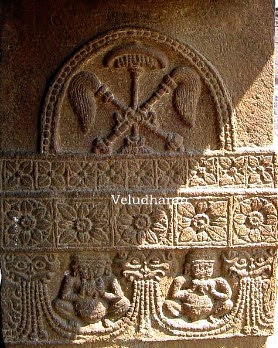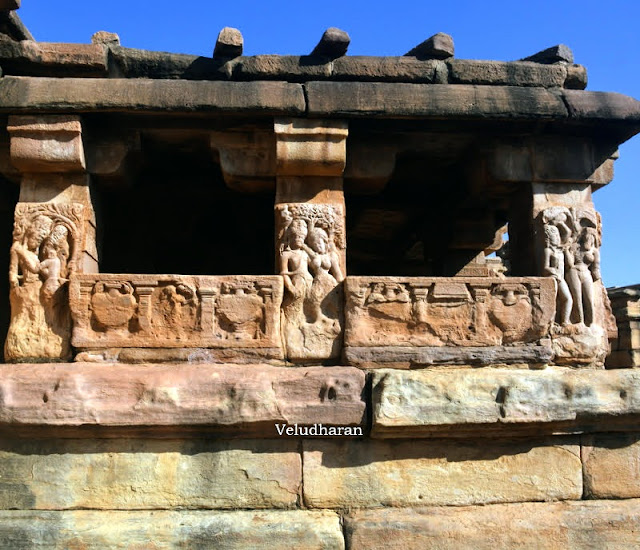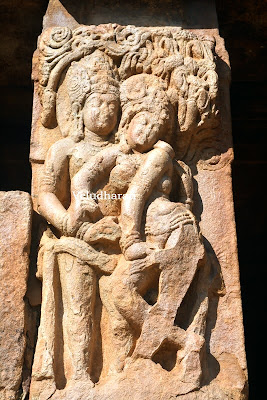The visit to this
Ladkhan Temple at Aihole was a part of “Hampi, Badami, Pattadakal, Mahakuta and
Aihole temples Heritage visit” organized by வரலாறு விரும்பிகள் சங்கம் Varalaru Virumbigal Sangam – VVS and எண்திசை வரலாற்று மரபு நடைக்குழு, between 24th December to 28th December
2022. I extend my sincere thanks to the organizers Mrs Radha and Mrs Nithya
Senthil Kumar and Mr Senthil Kumar.
HISTORY
OF AIHOLE
Aihole, is located in Hungund taluk of Bagalkot
district in northern Karnataka. Situated
on the bank of the river Malaprabha, Aihole was the cultural capital during the
period of the Western Chalukya dynasty of Badami ( 543-757 CE ) founded by
Pulakeshi-I ( 543-566 CE ) with Vätäpi - Bādāmi as the capital latter led by
Pulakeshi- II ( 610-642 CE ) and latter the succeeded by Rashtrakuta’s of Malkhed
( 757-950 CE ) and the Chalukya’s of Kalyana ( 950-1250 CE ). The town had trading
and administrative importance with a guild known as Ayyavole AinuRRuvar, ( a
guild of 500 elders ) mentioned in numerous ancient inscriptions.
The
legend
The name Ayyavolal is derived from Aryavolal
or Aryapura ( the valley of the elders ). In the local language, it is known as
Aivalli /Aiholli.
As per the legend, Parashurama, after killing
the kshatriyas, is said to have washed his axe in the Malaprabha river. The
waters of the river turned red due to blood, causing the people to exclaim, "Ai
Holi" ( Ai, the river...!!! ). Hence the name Aiholi, which has got corrupted to the
present name of Aihole.
TEMPLES OF AIHOLE COMPLEX
This Aihole Temple
complex consists of about 6 temples, constructed during early Chalukyas since
mid fifth Century, within the fortification alone in groups and there are more
than 50 temples can be seen out side. The details of the temples visited during our
Heritage Visit are….
1. Durga Temple
2. Surya Narayana
Temple
3. Ladkhan Temple
4. Gaudaragudi /
Gaudara Gudi Temple
5. Chakra Temple
6. Badigar Gudi
7. Ravanaphadi Cave
8. Huchchimalli
Temple, Ravana phadi.
லட்கான் கோயில்….
இக்கோயில்
5-6 ஆம் நூற்றாண்டுகளில் கட்டப்பட்டு இருக்கலாம் என கருதப்படுகின்றது (
புலிகேசி-1, காலம்… ?). லட்கான் என்ற முகமதிய துறவி இக்கோயிலில் வாழ்ந்ததாகவும்,
அதனாலேயே இது “லட்கான் கோயில்” என அழைக்கப்படுவதாகவும் ஒரு கருத்து நிலவுகின்றது. ஆரம்பத்தில் இது குதிரைகளைப் பலி இடுவதற்காக
கட்டப்பட்டதாகவும், பின்பு சூரிய கோயிலாகவும் அதற்கு பின்பு சிவன் கோயிலாகவும் மாற்றப்பட்டதாகக் கூறப்படுகின்றது. மண்டபத்தின் மீது சேதம் அடைந்த வடநாட்டு கட்டிடக்கலையின்
அமைப்பில் கட்டப்பட்ட விமானம் காணப்படுகின்றது. அவ்விமானத்தில் சூரியனின்
புடைப்புச்சிற்பம் அமைக்கப்பட்டு உள்ளதால் சூரியனுக்காக கட்டப்பட்ட கோயில் என்ற கருத்துக்கு வலு சேர்க்கின்றது. கருவறை பிற்சேர்கை ஆதலால் தனியாக
அமைக்கப்படவில்லை. மண்டபத்தின் மூன்று பக்கங்களிலும் மிகவும் நேர்த்தியாக
செதுக்கப்பட்ட ஜாலரங்கள் பொருத்தப்பட்டு உள்ளது. மண்டபத்தில், கங்கை, யமுனை, ஆண்,
பெண் காதல் சிற்பங்கள், காணப்படுகின்றன. தூணில் காணப்படும் முற்கால சாளூக்கியர்களின் இலச்சினை வராகத்தை வைத்து இக்கோயில் அவர்களால் கட்டப்பட்டது என உணரலாம்.
Surya Image
Maha Vishnu
The
Ladkhan Temple ( 450-600 CE )
According to the Dr.
Persy Brown, this is one the ancient temples of the Badami Chalukya's, "Ladakhan"
a Muslim saint lived in this temple. So it called Ladkhan Temple and latter dedicated
to Shiva Temple.
Originally a hall where horse sacrifice was
performed ( perhaps during Pulikeshi-l's period ) and later used for religious functions also.
It became a Surya temple and
subsequently a Shivalaya, at the centre of the elevated Rishaba mantappa
surrounded by partially damaged curve linear Shikhara with the sculpture of Surya
on the frontal side.
There is no separate garbhagruha and stone booth was added latter to the back wall to house deity. The walls to east south and north
have artistic lattice windows. The pillars here are massive. There is a frontal
mantapa added later with finely engraved pillars and there are fine
sculptures of amorous couple, Ganga and Yamuna. This is also one of the oldest
monuments named after one Ladkhan who had made this as his residence. One of the
pillars here has the early Chalukyan royal insignia Varaha engraved on it, which denotes that the temple was built during early Chalukya's period.
Ref
1. A Hand book on World Heritage Series Badami, published by Archaeological Survey of India.
2. A Hand book on Hampi, Badami, Pattadakal & Aihole issued by VVS in Tamil.
3. Temple architecture and Art of Early Chalukyas Badami, Pattadakal, Mahakuta, Aihole by George Michell.
LOCATION OF THE TEMPLE : CLICK HERE
--- OM SHIVAYA NAMA ---






















No comments:
Post a Comment